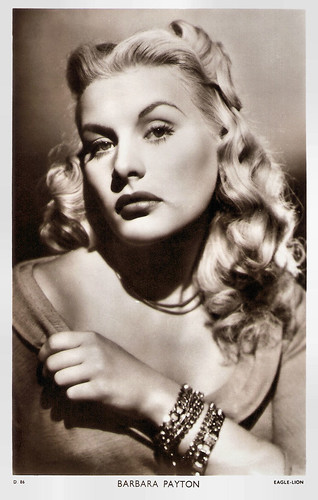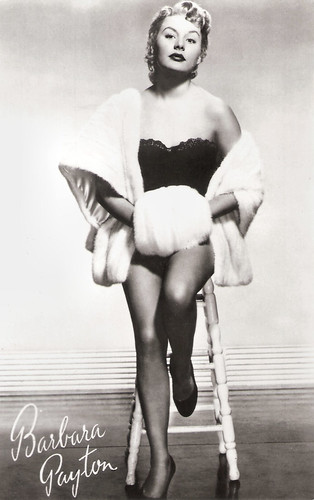
British postcard in the Picturegoer Series, London, no. D 86. Photo: Eagle-Lion.
Blossoming good looks
Barbara Payton was born Barbara Lee Redfield in Cloquet, Minnesota, in 1927. She was the daughter of Norwegian immigrants Erwin Lee Redfield and Mabel Irene Todahl. A son, Frank Leslie III was born in 1931. In 1938, the family moved to Odessa, Texas, where Payton’s father started a motel court. Both of Payton's parents had long-standing problems with alcohol.
As Payton was growing into maturity her good looks were also blossoming which garnered her attention. She was known as a lively girl, willing to please and she learned early in life that she had a potent effect on the opposite sex. In November 1943, the then sixteen-year-old eloped with her high school boyfriend William Hodge. The marriage seemingly amounted to nothing more than an act of impulsive, teen-age rebellion, and Payton did not fight her parent's insistence that the marriage be annulled. A few months later, she quit high school.
In 1944, she met her second husband, a decorated combat pilot named John Payton, who at the time was stationed at Midland Air Base. The handsome couple were married in 1945 and moved to Los Angeles where John enrolled at USC under the G.I. Bill. It was still early in their marriage that Barbara, restless and feeling confined by her life as a housewife, expressed a desire to pursue a modelling or acting career. Payton officially launched her modelling path by hiring the services of a local photographer who shot photos of her sporting fashionable outfits. This portfolio attracted the favourable attention of a clothing designer, Saba of California, who signed her to a contract modelling a line of junior fashion.
Her career progressed and in September 1947, the Rita La Roy Agency in Hollywood took her on as a client and brought her more work as a model in print advertising; notably in catalogues for Studebaker cars. She also appeared in clothing ads for such magazines as Charm and Junior Bazaar. During this period in her life, the couple welcomed their son, John Lee, who was born in February 1947. Payton managed to combine the responsibilities of wife, new mother and professional model, yet the strains on the Payton marriage finally reached the breaking point and Barbara and her husband separated in 1948.
Barbara took an apartment in Hollywood with her infant son, with whom she was very close. Payton's drive, fuelled by her high-energy personality, had become focused on promoting her career and showcasing her beauty around the town’s hot spots. She was labelled the 'Queen of the Night Clubs' by columnist Harrison Carroll. Her notoriety as a luminous, fun loving party girl in the Hollywood club scene ignited the attention of William Goetz, an executive of Universal Studios. In January 1949, he signed her, aged twenty-one, to a contract with a starting salary of $100 per week.
Payton first gained notice as a drop-dead gorgeous young woman in the film noir Trapped (Richard Fleischer, 1949), co-starring Lloyd Bridges. In 1950, she was given the opportunity to make a screen test for John Huston's production of the forthcoming MGM crime drama The Asphalt Jungle. She was not chosen and the part of the sultry mistress of a mob connected lawyer went to Marilyn Monroe.
After being screen-tested by James Cagney and his producer brother William, Payton starred with Cagney in the violent noir thriller Kiss Tomorrow Goodbye (Gordon Douglas, 1950). William Cagney was so smitten with Payton's sensual appeal and beauty that her contract was drawn as a joint agreement between William Cagney Productions and Warner Bros. who together saw fit to bestow on Payton a salary of $5,000 a week; a large sum for an actress yet to demonstrate star power at the box-office.
For a relative newcomer, Payton more than managed to hold her own in Kiss Tomorrow Goodbye among a cast of Hollywood veterans and alongside a super-star like Cagney himself. Her portrayal of the hardened, seductive girlfriend, whom Cagney’s character ultimately double-crosses, was critically praised in newspaper reviews of the film. Her acting skills were recognized and her significant screen charisma widely acknowledged. Kiss Tomorrow Goodbye was the highpoint in Payton’s career, the moment in time she was christened as a player with bonafide star power.

British postcard in The People series by Show Parade Picture Service, London, no. P. 1033. Photo: Universal-International.
A black eye and a tarnished reputation
Caught up in the glitz and glamour, Barbara Payton's career had started taking second place to a reckless life full of capricious romances involving a number of top stars and producers, many of them married. In 1949, she had a six month affair with Bob Hope in which he paid for her to live in a luxurious apartment. The affair ended when she began making demands for more money.
Her screen appearances opposite Gary Cooper in Dallas (Stuart Heisler, 1950), and Gregory Peck in Only the Valiant (Gordon Douglas, 1951), both Westerns, were lacklustre productions where her roles were no more than window dressing for the hero and did little to highlight her skills as an actress.
Payton's career decline began with the horror film Bride of the Gorilla (Curt Siodmak, 1951), co-starring Raymond Burr. However, her slightly lurid appeal still seemed to be enough to carry her through Tinseltown. According to rumours, she had affairs with producer Howard Hughes, Woody Strode, George Raft, Dallas co-stars Gary Cooper and Steve Cochran, John Ireland, and Texas oilman Bob Neal.
In addition to her first two marriages, Payton was married two more times. In 1950, she had met classy 'A' actor Franchot Tone and the two were later engaged. She was the subject of a spread in Confidential Magazine when Tone allegedly caught her in bed with Guy Madison. In 1951, while engaged to Tone, Payton began also having an affair with muscular B-movie actor Tom Neal, and she also proposed marriage to him. She allowed him to move into her apartment, which Tone was paying the rent for. She kicked him out when Tone returned from out of town.
Payton went back and forth publicly between Neal and Tone. On 14 September 1951, Tom Neal, a former college boxer, physically attacked Tone at Payton's apartment leaving him in an 18-hour coma with a smashed cheekbone, broken nose and concussion. Barbara ended up with both a black eye and a tarnished reputation. Payton and Tone, who was still recovering from his injuries, were married in 1951 in Payton's hometown of Cloquet, Minnesota. However, after being married, Tone discovered that she had continued her relations with the violence-prone Neal and Tone was subsequently granted a divorce in 1952. When Franchot Tone decided to divorce her, he had a private detective take pictures of her having sex with other men. He then sent the photos to all the major Hollywood studios, hoping they would ruin her career. They did.
Payton and Neal capitalized on the notorious press coverage by touring in plays such as The Postman Always Rings Twice, based on the popular 1946 film of the same name. They would also star together in The Great Jesse James Raid (Reginald Le Borg, 1953), a B-Western that received a limited released to theatres. In May 1953, Payton announced that she and Neal were to be married that summer in Paris. The couple broke up the following year.

Dutch postcard by DRC, no. F 154. Photo: Warner Bros.
I am not ashamed
Barbara Payton's hard drinking and hard living ultimately destroyed her both physically and emotionally. Gary Brumburgh at IMDb: "She went to England to try to rejuvenate her career, but no dice; it was over and her life was skidding out of control. Her once beautiful face now blotchy and her once spectacular figure now bloated, Barbara sank deeper into the bottle."
In England, she starred for the Hammer studio in the Science Fiction film Four Sided Triangle/The Monster and the Woman (Terence Fisher, 1953). And although Leonard Maltin called it a 'bomb' in his Movie Guide, among Hammer fans at IMDb both the film and Payton's acting are highly regarded.
Reportedly, she was also good in her last leading role in the Film Noir Murder Is My Beat (Edgar G. Ullmer, 1955). Linda Rasmussen at AllMovie: "Director Edgar G. Ulmer uses flashbacks and elliptical editing to good effect, but the film lacks any strong visual or narrative center. Barbara Peyton delivers a great performance as the ambiguous, mysterious femme-fatale. While still of some interest, Murder is My Beat lacks the power and grim vision of Ulmer's bleak gem, Detour."
In 1955, Payton married George A. 'Tony' Provas, a furniture store executive in Nogales, Arizona. They divorced in August 1958. In March 1956 she lost custody of her son John Lee Jr. after her ex-husband charged that she exposed their son to "profane language, immoral conduct, notoriety, unwholesome activities" and failed to provide the boy with a "moral education". From then on, her growing alcoholism and drug abuse led to multiple skirmishes with the law, including an arrest for the passing of bad checks.
In 1962, Payton was arrested for prostitution when she propositioned an undercover cop in a Sunset Boulevard bar. Later that year, she was stabbed by a drunk and received 38 stitches to heal the wound. In 1963, she published her autobiography, I Am Not Ashamed, which was ghost written by Leo Guild. She didn't want to be paid in cash or check, but asked for payment in red wine because there were claims on her cash. The book included unflattering photographs of Payton and admissions that she had been forced to sleep on bus benches and suffered regular beatings as a prostitute. In 1965, she was arrested and charged with possession of heroin and a hypodermic syringe.
In 1967, ill and after failed efforts to curb her drinking, Barbara Payton moved back to San Diego, California, to live with her parents. Several weeks later, the 39-year-old former starlet was found there on the bathroom floor - dead of heart and liver failure. Her son, John Lee Payton Jr., was serving in Vietnam when she died. Her life has been the subject of several books including Kiss Tomorrow Goodbye: The Barbara Payton Story (2007), by John O'Dowd, L.A. Despair: A Landscape of Crimes and Bad Times (2005), by John Gilmore, and B Movie. a Play in Two Acts (2014), by Michael B. Druxman.
Trailer Kiss Tomorrow Goodbye (Gordon Douglas, 1950). Source: Felixxxx9999 (YouTube).
Trailer for Bride of the Gorilla (Curt Siodmak, 1951). Source: Trailers, Sci, and/or Fi (YouTube).
Trailer for the British Film Noir The Flanagan Boy/Bad Blonde (Reginald LeBorg, 1953). Source: Captain Bijou (YouTube).
Sources: Gary Brumburgh (IMDb), Linda Rasmussen (AllMovie), Wikipedia and IMDb.
No comments:
Post a Comment